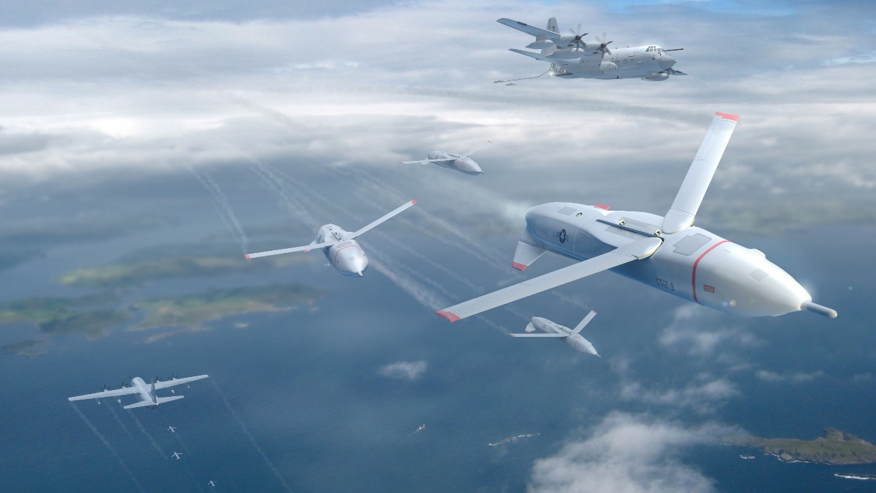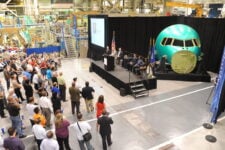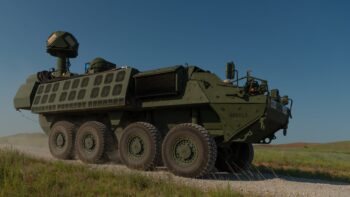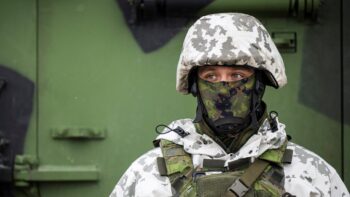
A DARPA rendering of a US Air Force-launched drone swarm. (DARPA)
The newest hot topic in defense is the Pentagon’s recently announced Replicator initiative, which seeks to to deliver thousands of attritable drones across multiple domains in the next two years. But where will those systems come from? In the op-ed below, Andrew Metrick of the Center for a New American Security argues that the Pentagon needs to be smart about investing in production capabilities for the new initiative to get off the ground.
Deputy Secretary of Defense Kathleen Hicks last week announced a new initiative called Replicator, intended to deliver thousands of low-cost attritable autonomous systems across multiple domains over the next 18 to 24 months. This is a laudable concept that builds on emerging lessons from Ukraine to focus on conflict in the Indo-Pacific, and at least on paper, could catalyze the burgeoning defense innovation ecosystem.
However, the unique operational requirements of the Indo-Pacific and the inherent challenges of achieving the desired production scale are real challenges that Replicator will have to deal with — and there simply aren’t many options available that fit both those targets. Ultimately, for an effort like Replicator to succeed, the Defense Department should seek to invest in new government-owned production facilities, not simply the systems themselves.
It is important to understand that the classes of drones relevant in the Indo-Pacific are fundamentally different than those relevant in Ukraine. While Taiwanese forces would be able to make use of small quadcopters and maritime drones in a territorial defense scenario, the closest the United States will likely be operating from is 100-200 plus nautical miles away, with the nearest sovereign US territory some 1,500 nautical miles away.
Foundationally, that means that small UAVs that can be produced in staggering numbers — the kind of capability so helpful in Ukraine, and which would be the most readily available for Replicator’s efforts — are, minimally, going to need to be brought to the fight by a larger platform with greater range. More likely, drones relevant to US operations in the Indo-Pacific regardless of domain will have to be larger than those used in Europe, and those systems are currently nowhere close to the kind of production levels Hicks hinted at.
This is the biggest impact of the oft-discussed tyranny of geography on any system produced by the Replicator initiative. Arguments over the sensors, datalinks and payloads of these low-cost attritable autonomous systems are sure to rage. If these systems are used to strike defended, mobile and/or hardened targets, their size and complexity may grow yet further. On first principles, the need for expanded range compared to their cousins on the Black Sea and in Ukrainian skies translates to larger, military specific systems that are more expensive, take more time to build, and come with larger, more complex supply chains.
As Hicks pointed out in her speech, all of these technological challenges are surmountable through the combination of the America’s vibrant, free market system with the Joint Force’s unmatched ability to “imagine, create, and master the future character of warfare.” However, production capacity for these military specific classes of systems has yet to materialize. They have unique economics, making it difficult to justify the business case for a new factory to build thousands of units in two years without high profit margins, access to exceptionally inexpensive capital, and/or potential for long-term use.
Ultimately, the United States lacks the production capacity required to turn these dreams into reality, and it’s hard to see what company would be willing to invest heavily to stand up production. Which leads the inescapable conclusion that the US government is going to have to invest directly to make the Replicator concept viable.
The dirty, uncomfortable and often unacknowledged fact is that today’s defense industry is built on the back of government investments from the 1940s and 1950s. In many ways, the United States has been coasting on 80-year-old foundational investments in heavy industry and production facilities. As an example, the Department spent over $2 billion adjusted for inflation as part of the Heavy Press Program during the 1950s. This forgotten industrial investment has been the lynchpin of the American aerospace industry from then until today. The F-35 rolls out of Air Force Plant 4, a government owned, contractor operated plant first constructed to build the B-24 Liberator bomber during World War II. Abrams tanks are remanufactured at another government owned, contractor operated facility that can similarly trace its heritage back to World War II. Wherever one looks across the defense industrial base, one finds that the arsenal of democracy, built with direct government funding, is not only aging but shrinking as well.
The department has made strides to fix this decline by devoting additional funds to preserving and expanding physical production capabilities for key, military specific items like submarines and munitions. In FY23, the Department began a $2.4 billion, five year program to bolster the submarine industrial base. In the FY24 budget, the Air Force allocated $6 billion over five years to improve industrial preparedness in the munitions sector. There is a clear and growing recognition that such investments are a vital part of defense policy, and that the Department needs to lead in key areas where no viable commercial market exists.
Given this recognition, it is surprising that the department has not immediately committed to production support funding as part of Replicator. Today’s innovation ecosystem alone cannot achieve the necessary production scale, especially for the less commercially viable classes of systems relevant in the Indo-Pacific. To build the autonomous systems in the desired quantities and with the appropriate capabilities, new production facilities are urgently needed.
There are three possible approaches for economically and rapidly creating new production plants with the necessary workforce and facilities. The first would be to leverage, expand and retool parts of existing depot facilities, such as Tinker Air Force Base in Oklahoma or Fleet Readiness Center East in North Carolina. The second would be to reclaim a former US military site, such as Naval Air Station Alameda in California or the Stratford Army Engine Plant in Connecticut. The third would be to repurpose a closed or underutilized automotive plant, such as the former GM Lordstown facility in Ohio.
These options have different pros and cons. If rapidly filled with the right equipment and tooling, they provide the foundation Replicator needs to succeed. While it is difficult to put an exact dollar figure on such a factory, commercial experiences make it hard to imagine it costing more than $5 billion. This is less than previously mentioned investments in other key areas.
Ultimately for Hicks’ vision to be realized, the department needs to step into the production void, reflect on the investments that made America the arsenal of democracy and commit to a new generation of government owned production facilities.
Andrew Metrick is a Fellow with the Defense Program at CNAS. Prior to joining CNAS, he was a campaign analyst and wargamer at Northrop Grumman.






















